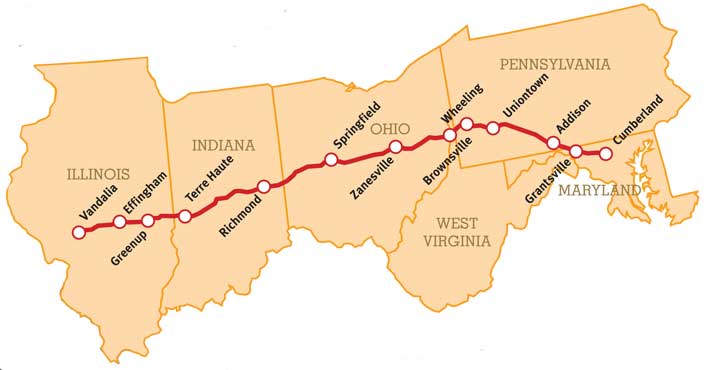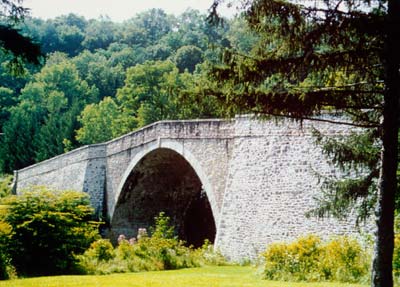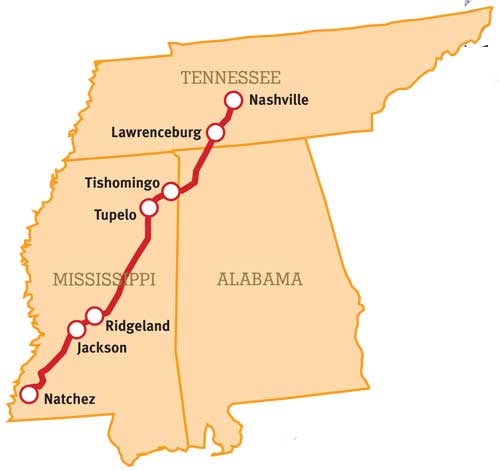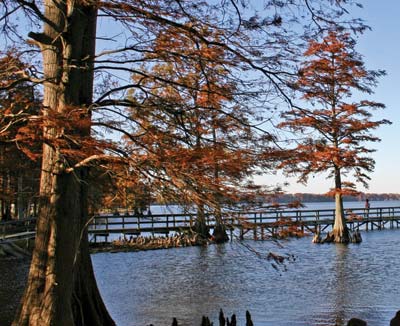Hit the Road!
Much has been written about America’s love affair with the automobile; the very phrase has become a cliché. But the essential truth remains that Americans love to travel. Immigration, Manifest Destiny, the Great Migration—the instinct to light out for Somewhere Else seems coded into our national DNA. In honor of that ancestral urge, here are three road trips inspired by the pioneer routes and trails that opened up this country to expansion. Leave time for side trips along the way; the journey, in this case, really is as important—and as fun—as the destination.
History Highway

In 1806 Thomas Jefferson approved federal funding for one of the first interstate road projects. Known today as the Historic National Road, it stretches 824 miles through six states, from the East Coast nearly to the Mississippi, following the modern I-70 for much of its length.
As befits the route that made the westward migration possible for thousands of settlers, the Road is strewn with sites of historical interest. From the eastern terminus near Hollins Market, the oldest of Baltimore’s public markets and centerpiece of the artsy Union Square neighborhood (market open Tuesday-Saturday; www.union-square.us), you’ll pass Casselman River Bridge State Park, as well as historic inns and tollhouses. From Maryland, the Road swings west through southern Pennsylvania, with a stop at the Fort Necessity National Battlefield, site of the first battle of the French and Indian War. The Old Petersburg Tollhouse, built from native-cut stone, still stands along the roadside.

Photo: Lardner/Klein Landscape Architects, Jim Klein
Passing through a corner of West Virginia, the Road continues into Ohio, where you can ponder the changes in American transportation at the Aviation Heritage National Historical Park in Dayton (www.aviationheritagearea.org). Cut across the entire breadth of Indiana, taking in the famous “Antique Alley”—an extensive loop encompassing more than 900 shops and dealers; it’s the ultimate destination for any fan of collectibles (www.visitrichmond.org). The Road ends in Illinois, the land of Lincoln. Leave time for visits to the Lincoln Log Cabin State Historic Site (www.lincolnlogcabin.org) as well as the Lincoln School Museum in Martinsville (open Sunday afternoons through the summer, 217-382-6666).
Tracing a Path

Following what is perhaps the oldest continuously used travel route in the U.S., the Natchez Trace Parkway— a 444-mile stretch of two-lane blacktop running south- by-southwest from Nashville to the banks of the Mississippi—began as a dirt trail used by the earliest European traders and missionaries, and by local Native American tribes for centuries before that. Travel here was once so hazardous that the trail was called “The Devil’s Backbone.” Today, the Parkway offers the natural beauty and rich cultural heritage of the South. Note: Because it sits on mostly high ground, only a few areas of the Parkway were impacted by the flood waters that hit the Nashville area earlier this year. While the entire Parkway is expected to be passable by summer, it’s always a good idea to call ahead and confirm your itinerary.

Photo by Dennis Adams
On the Parkway, two wheels are as good as four, as the entire road is a designated bicycling area. Along the way, there’s boating and fishing at Laurel Hill Lake in Lawrenceville, Tennessee (931-762-7200), and hiking, camping, and nature trails at Tishomingo State Park in Mississippi (662-438-6914). Or simply stop to smell the wildflowers tracing the trail.
The Parkway is rich in Native American historical sites. In Tupelo you will find the ceremonial Emerald Mound, the Grand Village of the Natchez, and the Chickasaw Village and Fort. You can also pay homage to “the King” at the Elvis Presley Birthplace (www.elvispresleybirthplace.com).
At the Mississippi Crafts Center in Ridgeland, you’ll find artwork and housewares from regional crafters working in traditional and contemporary forms (www.mscrafts.org). Finally, surrender to the charms of old Natchez and view gracious antebellum homes in the city’s historic district (www.natchezms.com).
Rolling on the River

The mighty Mississippi is, in a way, the original interstate highway, used for ages to transport goods and passengers downriver. Trace that epic path on the Great River Road National Scenic Byway—a route following the course of the Mississippi through 10 states and over 2,000 miles, from the headwaters to the delta, from St. Paul to New Orleans, straight through the heart of America.
Spend a week or two following Old Man River downstream—through Minnesota, Wisconsin, Iowa, Illinois, Missouri, Kentucky, Tennessee, Arkansas, Mississippi, and finally, Louisiana—and you’ll sample a great swathe of the American experience. Along with unparalleled views of the “Father of Waters,” there are ample stops for bird and wildlife watching, outdoor recreation, shopping, historical sightseeing, and more.

Photo by Amie Vanderford.
Music runs deep along the river, and many festivals and performance series are held along the route, from Wisconsin’s Riverfest (June 30-July 4, www.riverfestlacrosse.com), presenting dozens of musical groups on six stages, to the annual blues and jazz fests in Davenport, Iowa; from the St. Louis Municipal Opera—this year featuring live outdoor performances of Beauty and the Beast, The Sound of Music, Damn Yankees, and more—to the renowned jazz clubs of New Orleans (www.riverroads.com).
It’s Road Trip Season!
Americans love to travel. Immigration, Manifest Destiny, the Great Migration—the instinct to light out for Somewhere Else seems coded into our national DNA. In honor of that ancestral urge, the July/August issue of The Saturday Evening Post features road trips inspired by the pioneer routes and trails that opened up this country to expansion. Here are two bonus trips worth considering for your summer travels.
Riding with the Rail-Splitter
The Lincoln Highway, dedicated in 1913, originally ran from New York’s Times Square to San Francisco’s Lincoln Park. Once known as “America’s Main Street,” most of the original route has long since been decommissioned or assimilated into other, newer highways. But a stretch of the original alignment still runs through northern Illinois, from the Chicago metro area to the Mississippi River. Redesignated as a national scenic byway, the 179-mile Illinois Lincoln Highway now makes a perfect weekend jaunt.

© July 2002 Illinois Lincoln Highway Coalition
Along the Highway, wander the tree-lined streets of Geneva, still graced by Federal-era homes as well as quaint shops in the still-vibrant downtown section (www.genevadowntown.org). Prefer outdoor recreation? Play a few holes at one of the half-dozen golf courses scattered along the Highway, or enjoy hiking, fishing, or touring a historic grist mill at Franklin Creek Natural Area (www.franklingroveil.org). Take in sights such as the majestic Black Hawk statue towering above the Rock River, where paddle-wheeler riverboats still ply the waters (cruises run April through November: www.oregonil.com). Or learn about one of the iconic names in American industry at the John Deere Historic Site, where the great blacksmith perfected “the plow that broke the plains” (Grand Detour, Illinois, 815-652-4551).
Wherever you stop along the way, keep an eye out for the original mile markers. To prove the project’s viability—and the advantages of paved roads, at a time when the concept was still a novel one—the Lincoln Highway was first paved in short stretches called “seedling miles,” which are marked by commemorative signs (www.drivelincolnhighway.com).
Road to Ruins
Car travel is a great way to get from place to place. But an expedition on the Trail of the Ancients—which runs through parts of Colorado and Utah—is a trip back in time. That’s because the Trail is dotted with some of the oldest and best-preserved Native American archeological sites in the entire country. Take a week roaming the Trail’s 480 miles, and catch a glimpse of this corner of America as it was before the coming of Europeans. In Mesa Verde National Park alone, hundreds of cliff dwellings are little changed with the passage of centuries (www.visitmesaverde.com). At the nearby Anasazi Heritage Center in Dolores, Colorado, history comes alive with interactive exhibits, hands-on activities, and live demonstrations of tribal lifeways (970-882-5600). Walk in the footsteps of the Ancestral Puebloan people at Edge of the Cedars State Park and Museum in Blanding, Utah (closed Sundays: www.stateparks.utah.gov), exploring the ruins of an ancient settlement.

© 2006 John Mocko
Farther along the Trail, you’ll find some of the most stunning and iconic scenery in the Southwest. The soaring sandstone buttes of Monument Valley Navajo Tribal Park (www.navajonationparks.org) are familiar from dozens of Hollywood Westerns; about 30 miles to the northeast, the lesser-known Valley of the Gods offers vistas less familiar but no less ravishing. Leave time for a rafting trip on the San Juan River, booked through Wild Rivers Expeditions (800-422-7654 or www.riversandruins.com). End your journey at Four Corners Monument, the only spot in the U.S. where you can stand in four states at once. (At press time, the park was scheduled to reopen in June, 928-871-6647.)
To plan a complete itinerary, explore the National Scenic Byways Project at www.byways.org.
For more inspiring trips, including the Historic National Road, the Natchez Trace Parkway, and the Great River Road National Scenic Byway, look for the Jul/Aug 2010 issue of The Saturday Evening Post (on newsstands the first week of July) or subscribe here.